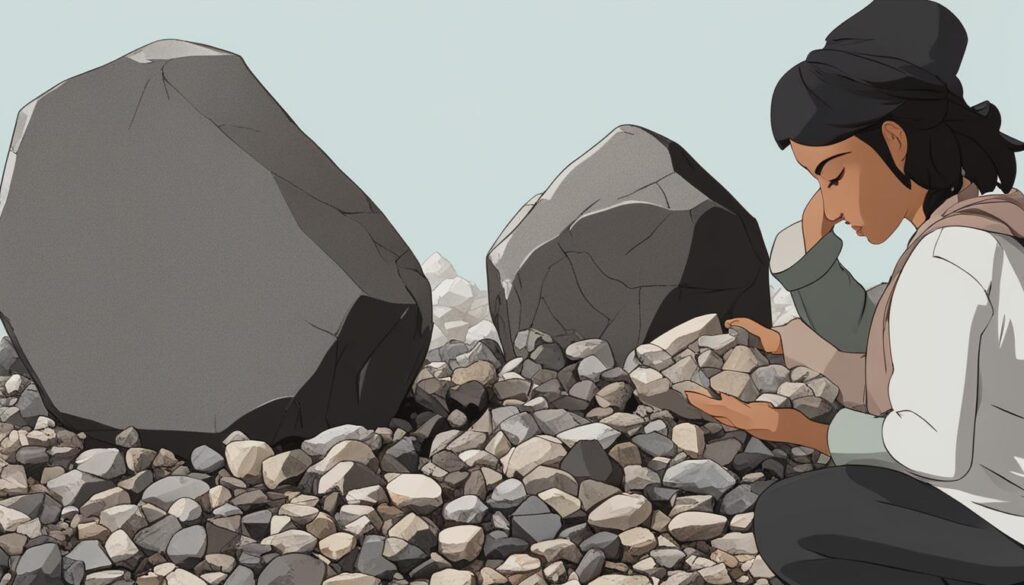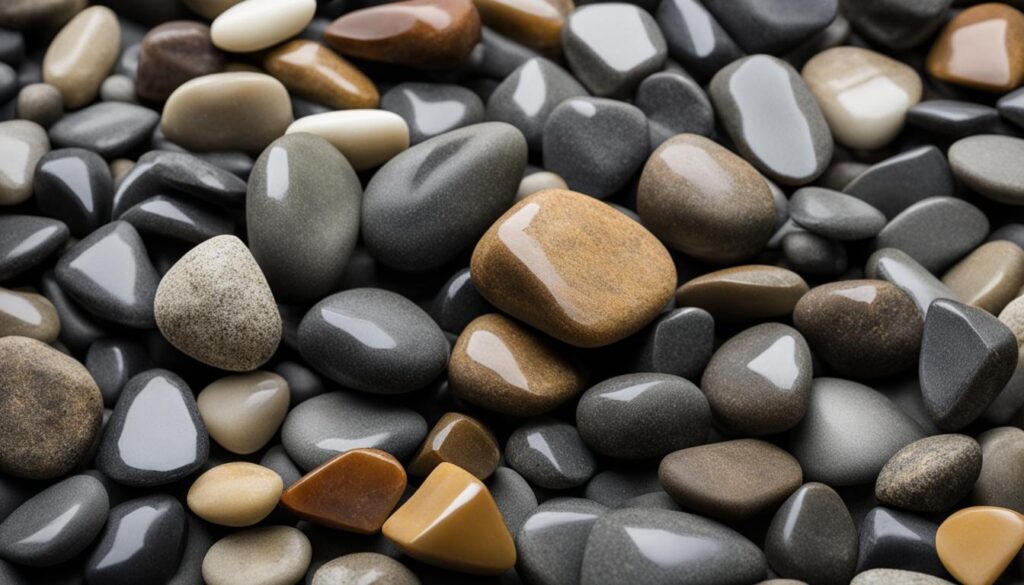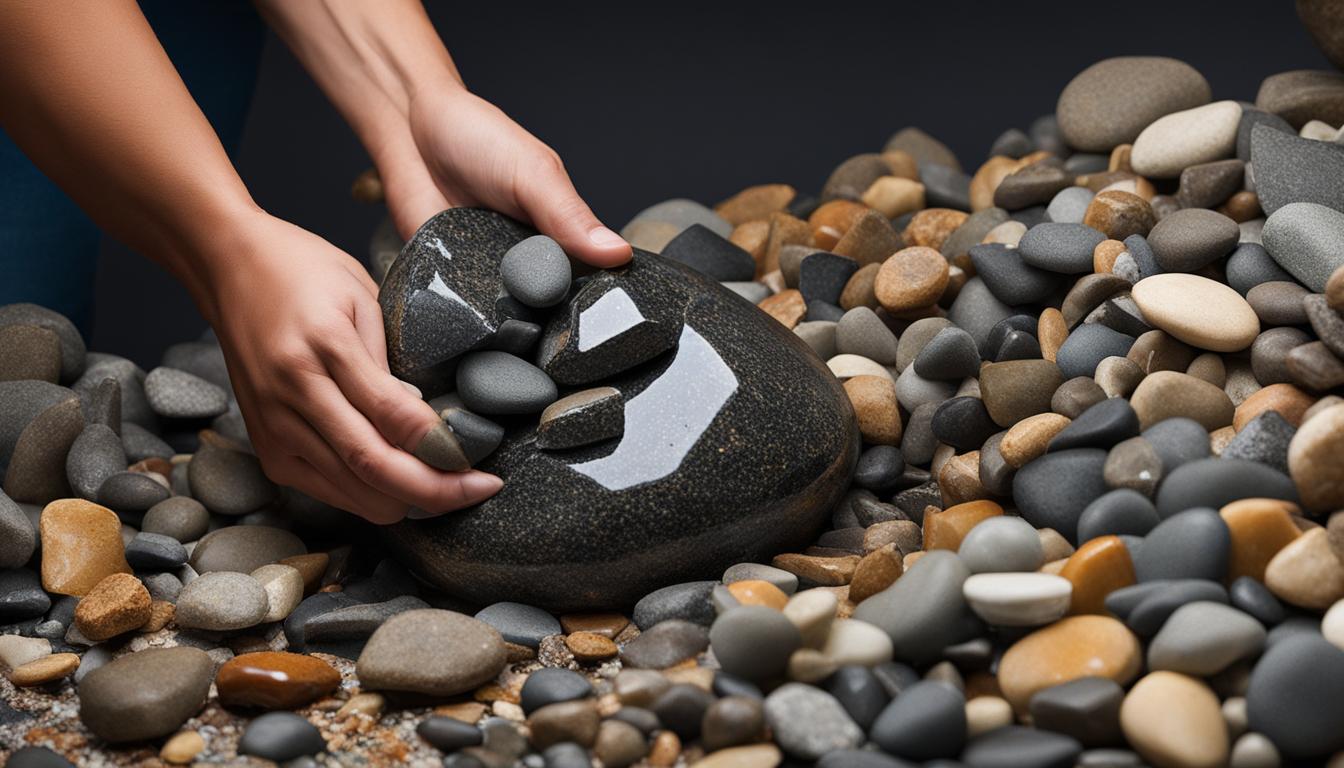This post contains affiliate links.
Embarking on the journey of rock tumbling, you might find yourself eager to witness the transformation from rough stones to polished gems. Mistakes, however, are part of the learning curve. To ensure your labor results in dazzling success, it’s crucial to be aware of common mistakes to avoid in rock tumbling. Broken stones, a lack of polish, and unsightly marks can all be the result of minor oversights, from hastiness to using the wrong abrasives. This guide will equip you with rock tumbling tips to avoid mistakes, helping you become meticulous in your process and avoid the pitfalls that lead to disappointing outcomes.
Whether you’re a novice or a seasoned lapidary, understanding the dos and don’ts is imperative. Remember, avoiding mistakes in rock tumbling not only spares you frustration but also saves time and resources. Let’s dive into how to sidestep common errors in rock tumbling and refine your skills for that perfect polish.
Key Takeaways
- Become familiar with the nuances of rock tumbling to prevent common blunders.
- Understand why rushing the tumbling process can lead to unsatisfactory results.
- Learn to choose the right abrasives to enhance the quality of your rock finishes.
- Implement meticulous cleaning practices between stages to avoid grit contamination.
- Avoid overloading your tumbler to ensure an even and satisfying polish on all stones.
- Appreciate the importance of patience and attention to detail in mastering rock tumbling.
Understanding the Rock Tumbling Process
Embarking on a rock tumbling journey is not without its pitfalls. To ensure you sidestep rock tumbling errors to avoid, it’s vital to grasp the intricacies of this delicate art. With rocks coming in various hardness, sizes, and shapes, each kind dictates its unique treatment in the tumbler – aligning the correct levels of abrasion and tumbling duration is key.
Let’s dive into rock tumbling blunders to avoid. For starters, don’t rush to add your stones and grit; slow down and consider each factor. An incorrect balance could end disastrously, damaging your precious finds or leading to lackluster results. Adjusting water levels and grit sizes throughout the process is not just recommended – it’s essential.
| Rock Hardness | Grit Size | Tumbling Time | Water Ratio |
|---|---|---|---|
| Soft | Fine | Shorter | Higher |
| Medium | Medium | Moderate | Medium |
| Hard | Coarse | Longer | Lower |
As you can see, a one-size-fits-all approach does not apply to rock tumbling. Paying attention to the table above will help you avoid common rock tumbling pitfalls to avoid. Remember that experimentation can be valuable. If your first attempt is less than perfect, don’t be disheartened—treat it as a learning curve.
Every stone is unique, and only by respecting its individual needs can you transform it into a polished gem.
- Inspect your rocks for flaws before starting.
- Match the grit size to the rock’s hardness.
- Gauge the water amount by the look and feel of the slurry.
- Monitor the tumbling process and be ready to make adjustments.
Your rock tumbling journey is precisely that—a journey. With each tumbled batch, your knowledge deepens and your technique refines. By avoiding these common rock tumbling errors to avoid, your rocks will soon display the gloss of success that only patience and precision can achieve.
Preventing Equipment Wear and Tear
To ensure the longevity of your rock tumbling endeavors, recognizing common mistakes when rock tumbling that can lead to wear and tear on your equipment is paramount. Regular inspection and maintenance are key to preventing potential breakdowns and costly repairs, particularly for popular equipment brands like Harbor Freight and National Geographic tumblers. You should look out for any signals that indicate your tumbler is working harder than it should, such as unusual noise or excessive barrel wear.
Regular Inspection and Maintenance
Regular checks are critical to catch the early signs of stress on your rock tumbling equipment. Mistakes to avoid while rock tumbling include neglecting to observe for worn belts, bearings, and signs of degradation in the tumbler’s barrel, such as leaks or cracks. By addressing these problems promptly, you can enhance your machine’s performance and prevent interruptions in your rock tumbling projects.
Investing in High-Quality Tumblers
While initial costs may be higher, investing in reputable machinery like Lortone tumblers can significantly reduce the frequency of rock tumbling mistakes to avoid. Lortone tumblers are renowned for their durability and efficient operation, which not only promise smoother tumbling sessions but also demand less maintenance over time. This investment translates to uninterrupted creation of beautifully polished stones and superior results in your rock tumbling practice.
| Feature | Harbor Freight Tumbler | Lortone Tumbler |
|---|---|---|
| Build Quality | Basic | Compact & Robust |
| Operation Noise Level | Moderate | Quiet |
| Maintenance Needs | Frequent | Minimal |
| Part Availability | Varied | Readily Available |
| Long-term Cost | Higher due to Possible Repairs | Reduced due to Durability |
Finding the Perfect Rock Tumbling Balance
Discovering the ideal equilibrium when tumbling rocks is a critical skill, as it can mean the difference between amateur and professional-grade results. One of the common mistakes to avoid in rock tumbling is not paying attention to the delicate balance between the number of rocks, the quantity of filler media, and the machine’s carrying capacity. The harmony of these elements ensures that your rocks tumble correctly without causing unnecessary pressure on the equipment. Let’s talk about how you can steer clear of these rock tumbling errors to avoid.
Firstly, the number of rocks in your tumbler should be just right. Too many and your tumbler may not function efficiently, risking damage to both the stones and the equipment. Too few, and the rocks may not polish properly or may become chipped in the process. Secondly, it is important to make sure that you are using the right amount of filler, such as ceramic pellets, to cushion the rocks throughout their tumbling. Thirdly, each rock tumbler has its weight limitations – it’s essential to respect these to prevent overloading.
| Tumbler Capacity | Ideal Rock Load | Filler Media | Notes |
|---|---|---|---|
| 3 lb | 2.5 lb | Ceramic Pellets | Perfect for beginners with smaller, less robust machines |
| 6 lb | 5 lb | Plastic Pellets | Suitable for more intermediate tumbles with a medium batch of rocks |
| 12 lb | 10 lb | Mixed Media | Ideal for advanced tumbling, allowing for larger and more various rock loads |
Always keep in mind that achieving that perfect polish is not just about avoiding common mistakes to avoid in rock tumbling; it’s about patience, precision, and understanding the capabilities of your tumbler. By respecting these aspects, you’ll be well on your way to creating beautifully polished stones without excess strain on your tumbler.
Choosing the Right Grit for Optimal Tumbling
As you delve into the world of rock tumbling, understanding the connection between rock hardness and grit becomes pivotal. Choosing the incorrect grit can be one of the mistakes to avoid while rock tumbling, and here, you’ll discover rock tumbling tips to avoid mistakes and boost your chances of achieving a brilliant polish.
Adjusting Grit Based on Rock Hardness
Each rock, unique in its composition, will react differently to the tumbling process. So, how do you avoid the prevalent rock tumbling blunders associated with mismatched grits? Begin by classifying your rocks by hardness; softer stones will require a finer grit, while harder stones can handle a coarser grit for the initial stages of tumbling. Mindful adjustment of grit coarseness ensures that each rock’s surface is immaculately smoothed without inducing scars or microfractures.
Importance of Correct Grit Size
Equally as important is the size of the grit you select. A grit too large can inflict scratches that are difficult to polish out, diminishing the stone’s final appearance. Conversely, using a grit that’s too fine from the outset may not create enough abrasion to bring out the natural sheen of your stones. It’s essential for tumblers to align their grit size choices with the specific stage of tumbling they’re in – from initial shaping to the final polish.
Here is a guide to help you match the most commonly used grit sizes with the corresponding tumbling stages:
| Stage | Grit Size | Function |
|---|---|---|
| Initial Shaping | 60-90 | For rough edges and shaping |
| Medium Grind | 120-220 | Smoothing surfaces further |
| Pre-Polish | 500 | Setting stage for final polish |
| Final Polish | 1000-3000 | Achieving a gleaming finish |
Common Mistakes to Avoid in Rock Tumbling
Rock tumbling, though a rewarding hobby, can be fraught with potential errors that might dampen your results. Steering clear of these pitfalls can ensure that your tumbling experience is both enjoyable and successful. Below are some key rock tumbling tips to avoid mistakes that both beginners and veterans can encounter.
Overfilling the Tumbler Barrel
One of the fundamental rock tumbling errors to avoid is overcrowding the barrel. It’s tempting to maximize your batch size to polish more stones simultaneously, but overcrowding can impede the tumbling motion needed to achieve a uniform grind and polish. This rock tumbling pitfall can lead to stress on your machine and even cause mechanical failures, such as belt breakage. Always adhere to the manufacturer’s recommended capacity to sidestep these common mistakes when rock tumbling.
Incorrect Use of Polishing Media
Another aspect often overlooked is the correct use of polishing media. Ceramic media serves to cushion the stones during tumbling, but fresh media can be coarser than you might expect. Without proper “breaking in,” these can leave undesirable scratches on your stones. Treat ceramic media as you would your rocks: if it’s been in the coarse grind, allow it to progress to finer stages alongside your stones to avoid such rock tumbling mistakes.
Skipping Necessary Cleaning Between Stages
Meticulous cleaning between each tumbling phase is paramount. Leaving behind remnants of coarser grit can result in cross-contamination that mars the finish of your stones in later stages. Vigilant cleaning is thus one of the essential rock tumbling tips to avoid mistakes, ensuring that each polish stage begins with a clean slate and preventing those scratch marks that can detract from the final sheen of your stones.
By keeping these tips in mind and methodically planning your tumbling process, you can avoid common tumbling errors and achieve the gleaming results you strive for with each batch of stones.
Mitigating Breakage and Ensuring Even Polish
One of the most common mistakes to avoid while rock tumbling is the breakage of rocks due to pre-existing fractures. To prevent this unfortunate outcome, always begin with a careful selection of rocks, ensuring they are free from visible cracks or weaknesses. By controlling the agitation within your rock tumbler, you can protect your stones throughout each stage of the tumbling process.
Rock tumbling is as much an art as it is a science, and achieving an even polish requires a balanced approach. Manage the tumbling environment by adjusting the speed of your tumbler and maintaining a balanced slurry—this not only affects the outcome but can also keep your rocks from breaking under stress.

- Use a balanced slurry with sufficient additives to achieve an even polish.
- Avoid mixing stones of different hardness in one batch, as this can lead to an uneven finish and potential breakage.
- Address any issues such as edge chipping or spalling by adjusting earlier tumbling stages.
- Increase the viscosity of your solution, when necessary, to provide additional protection during tumbling.
By incorporating these strategies, you’ll enhance the durability of your stones and achieve a quality finish without unwelcome surprises. Remember, patience and a meticulous approach significantly reduce tumbling errors, leading to beautifully polished stones that meet or exceed your expectations.
Recognizing and Solving Tumbling Pitfalls
As you delve into the fine detail of rock tumbling, it becomes clear that some simple missteps can cause unsightly setbacks in your results. Tackling these pitfalls head-on with informed solutions will set you on a path to gleaming success. Now let’s zoom in on how to pinpoint and remedy these common stumbling blocks, enhancing your rock tumbling technique.
Identifying and Correcting Pre-Polish Errors
It’s disheartening when, after hours of tumbling, your rocks lack the expected gleam. Oftentimes, this dullness is a telltale sign of gritty residue hiding within the crevices of your rocks, dodging the reach of your polish. By re-running the batch and adding finer-grade small stones, you provide additional friction and coverage, polishing those hard-to-reach areas. Heed the rock tumbling tips to avoid mistakes like these, ensuring your rocks receive a thorough edge polish before progressing to the final stage.
Dealing with Tumbling Variables like Speed and Viscosity
Vibratory tumblers require a keen eye on the speed settings to avert the blunder of spalling. If your rocks are showing these unwelcome signs, dialing back on speed may be in order. Additionally, the solution’s viscosity should not be overlooked. Achieving the right consistency can mean the difference between a flawless surface and one marred by blistering. With mindful adjustments, you can rectify these rock tumbling errors to avoid a finish that’s anything less than perfect.
| Common Mistake | Potential Consequence | Tips to Avoid |
|---|---|---|
| Skipping Thorough Pre-Polish | Dull rocks lacking shine | Add smaller stones in pre-polish for better coverage |
| Incorrect Speed on Vibratory Tumblers | Spalling, unwanted rock flaking | Monitor and adjust speeds according to rock type and size |
| Ignoring Solution Viscosity | Surface fractures such as blistering | Test and alter viscosity for smoother tumbling action |
Remember, refining your practice involves persistence and the will to learn from—and not repeat—rock tumbling blunders. Equipped with these rock tumbling tips to avoid mistakes, take each tumble as a step forward in mastering the craft.
Mastering the Art of Patience in Rock Tumbling
When it comes to rock tumbling, patience isn’t just a virtue—it’s a necessity. Stepping away from the frantic pace of today’s fast-moving world, this hobby invites you to slow down, as each rock’s unique characteristics emerge at their own pace. What you must understand is, with each turn of the tumbler, you’re not just polishing stones, but also nurturing your capacity for attention to detail and resilience.
As you embark on this transformative journey, remember that avoiding mistakes in rock tumbling starts with a pledge to patience. The temptation to speed through the stages may knock on your door, but keeping in mind the cost of haste—namely, a less than stellar shine on your treasures—can serve as a timely reminder that the best results often stem from letting nature take its course.

Allowing Adequate Time for Each Tumbling Stage
Each stone you tumble has its own story, shaped by the forces of nature. Respecting that narrative means allowing each tumbling stage the time it truly calls for. Whether it’s the coarse grind or the final polish, cutting corners can mar both the beauty you seek and the very stones you hope to treasure.
Resisting the Urge to Rush the Process
The finish line may be alluring, but rushing there can lead you astray. If you find your batch lacking that desired gleam, resist the urge to let impatience win. Take the time to extend the current stage or even redo previous stages if necessary. Your commitment to doing things right—rather than simply doing them quickly—will pay dividends in the perfection of your polished rocks, reflective of the common mistakes to avoid in rock tumbling.
Your journey in mastering the ancient art of rock tumbling requires a steady hand and a calm mind. Tread with care, for in the realm of tumbling, time is an irreplaceable gem, one that guarantees a splendor in your stones that is well worth the wait.
Conclusion
In wrapping up this comprehensive exploration of rock tumbling, it’s evident that the craft is as much about science as it is an art. Navigating the intricate intricacies of this pastime means being vigilant to avoid the common pitfalls that can mar the journey. Among the rock tumbling mistakes to avoid are easily recognizable missteps such as over-zealously filling your tumbler or selecting an incompatible tumbling media. These errors, while common, can overshadow the process, hinder your results, and interrupt the gleam of a well-polished gem.
Your stone voyage doesn’t only hinge on avoiding these mistakes; it thrives on your patience and diligence. In essence, you’re not simply tumbling stones; you’re cultivating stories and enhancing natural beauty through refined precision. Remember, you’re the artist, and every tumble is a brushstroke on your stone canvas. With time and a nuanced touch, common mistakes when rock tumbling transform into guiding posts on the road to mastery. It’s your patience and perseverance that will render a collection that radiates with a dazzling narrative of textures, colors, and shine.
May your hands be guided by knowledge and your results inspire awe with every polished turn. Embrace each challenge as an opportunity to learn and each triumph as a testament to your evolving skills. Here’s to the gems that await your discovery, to the imperfections that teach resilience, and to the journey that calls forth the luster within each unique rock. Engage with your craft, share its brilliance, and let the stones echo their captivating stories through their unparalleled sparkle and shine.
FAQ
What are the common mistakes to avoid in rock tumbling?
To avoid common mistakes in rock tumbling, ensure you’re not overfilling the tumbling barrel, using the wrong type of grit size, rushing the tumbling stages, or failing to clean the equipment and stones thoroughly between each stage. Additionally, regularly inspect and maintain your equipment to prevent wear and tear.
How do you understand the rock tumbling process to prevent errors?
Understanding the rock tumbling process involves knowing different rocks’ requirements and how to adjust tumbling techniques, like the amount of water and tumbling times. Each rock may need different levels of abrasion, and experimentation is key to tailoring the process to achieve the best results.
Why is regular inspection and maintenance of tumbling equipment important?
Regularly inspecting and maintaining your equipment is crucial to detect wear and tear early on. This can prevent costly breakdowns and ensure your tumbler, whether it’s from brands like Harbor Freight or National Geographic, operates efficiently for successful results.
What does finding the perfect balance in rock tumbling entail?
Finding the perfect balance in rock tumbling includes choosing the right number of rocks for the barrel, adding the appropriate filler or cushioning material, and ensuring that the tumbler isn’t overloaded or under-filled. An ideal load allows for the rocks to grind against each other effectively without excess stress on the equipment.
How do you choose the right grit for optimal tumbling?
Choosing the right grit for optimal tumbling involves matching the coarseness to the hardness of the rocks and ensuring the size is correct for each stage of the process. Starting with a coarser grit and moving to finer grains helps to smooth and polish the stones effectively without causing damage.
How can overfilling the tumbler barrel be a mistake?
Overfilling the tumbler barrel can prevent the rock from tumbling properly and cause inadequate grinding action. This mistake can result in mechanical failures, such as belt breakage. Following the manufacturer’s guidelines for load capacity will help you avoid this common issue.
Why is the use of polishing media important, and how can it be done incorrectly?
Polishing media like ceramic pellets is used to cushion the stones during tumbling and fill any extra space. Using media incorrectly, especially if it’s not been properly “broken in,” can lead to scratches on your rocks. It’s essential to prepare your media correctly before each step of the tumbling process.
What consequences might skipping cleaning between stages have?
Skipping the cleaning process between tumbling stages can lead to cross-contamination of grits, which can cause scratching and damage to your rocks during subsequent stages. Thoroughly cleaning your stones and barrel ensures that each stage starts fresh, which is key to achieving a beautiful polish.
How can you mitigate breakage and ensure an even polish?
To mitigate breakage and ensure an even polish, select rocks without fractures, adjust the tumbling solution’s viscosity, and avoid mixing rocks of different hardness. If chipping occurs, revisit earlier stages with more cushioning to protect the stones during tumbling.
How can you recognize and solve tumbling pitfalls such as pre-polish errors?
Recognizing and solving pre-polish errors often involves inspecting the stones for a lack of shine and re-tumbling with additional small stones or clean grit, if necessary. Adequate preparation and patience are often required to fix these issues without returning to the more abrasive stages.
What is the importance of adjusting tumbling variables like speed and viscosity?
Adjusting tumbling variables such as speed and viscosity is crucial for reducing problems like spalling or blistering, particularly with vibratory tumblers. The speed can affect the level of agitation while the viscosity impacts the cushioning around the stones, both of which are essential for a smooth tumbling process.
Why is allowing adequate time for each tumbling stage important?
Allowing adequate time for each tumbling stage is crucial for achieving the level of polish and smoothness desired on your rocks. Cutting the time short can lead to under-polished stones. Every rock has unique characteristics that dictate how much tumbling time is necessary for optimal results.
What are the ramifications of rushing the rock tumbling process?
Rushing the rock tumbling process can lead to incomplete polishing, and you may have to redo steps, which is more time-consuming in the long run. Taking your time with each stage and being patient with the process are vital for developing fully polished, lustrous stones.
Source Links
- https://www.goldrushtradingpost.com/common_rock_tumbling_problems_
- https://gmrockshop.com/blogs/news/rock-polishing-tips-tricks
- https://rockstumbling.com/troubleshooting-common-rock-tumbling-issues-why-aren-t-my-tumbled-rocks-shiny
This post contains affiliate links.

